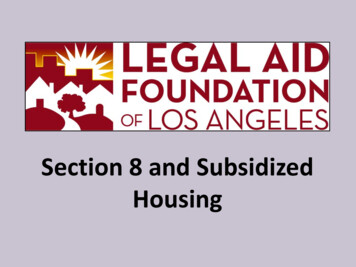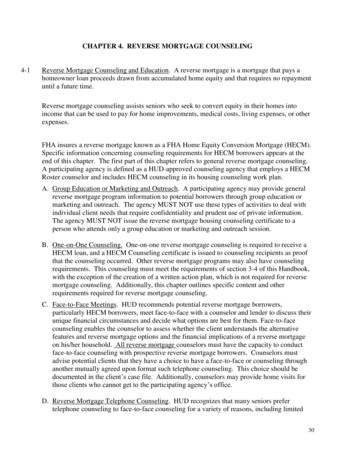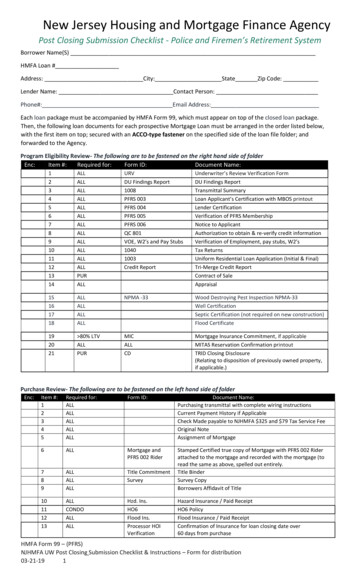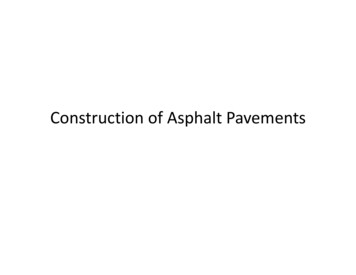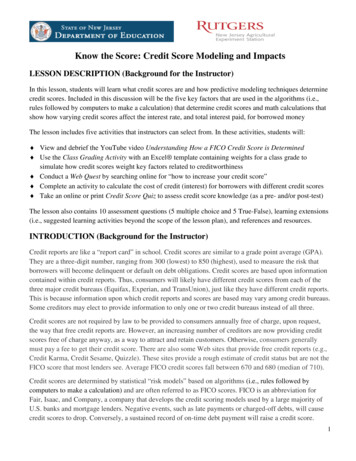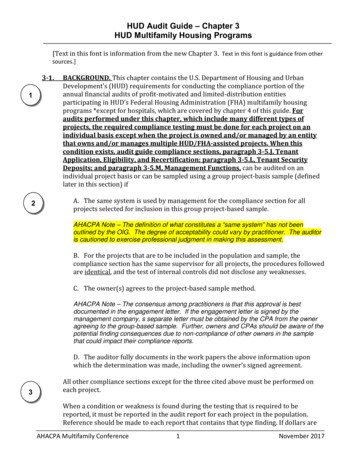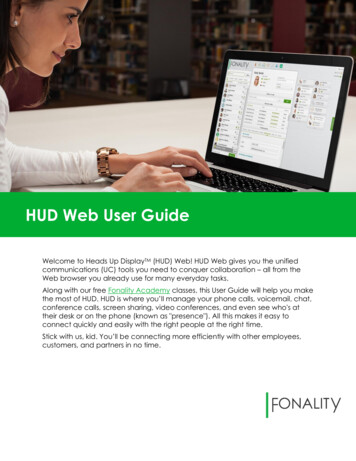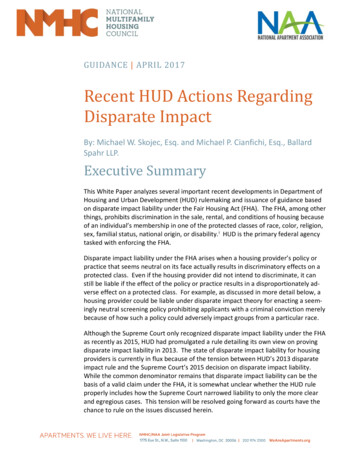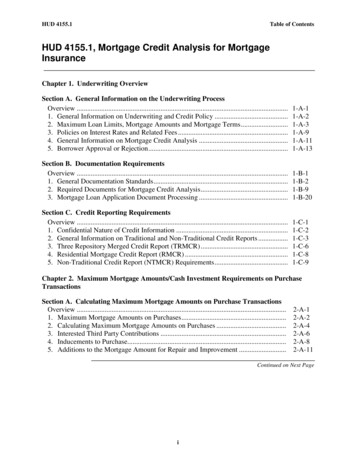
Transcription
HUD 4155.1Table of ContentsHUD 4155.1, Mortgage Credit Analysis for MortgageInsuranceChapter 1. Underwriting OverviewSection A. General Information on the Underwriting ProcessOverview .1. General Information on Underwriting and Credit Policy .2. Maximum Loan Limits, Mortgage Amounts and Mortgage Terms .3. Policies on Interest Rates and Related Fees .4. General Information on Mortgage Credit Analysis .5. Borrower Approval or Rejection .1-A-11-A-21-A-31-A-91-A-111-A-13Section B. Documentation RequirementsOverview .1. General Documentation Standards .2. Required Documents for Mortgage Credit Analysis .3. Mortgage Loan Application Document Processing .1-B-11-B-21-B-91-B-20Section C. Credit Reporting RequirementsOverview .1. Confidential Nature of Credit Information .2. General Information on Traditional and Non-Traditional Credit Reports .3. Three Repository Merged Credit Report (TRMCR) .4. Residential Mortgage Credit Report (RMCR) .5. Non-Traditional Credit Report (NTMCR) Requirements .1-C-11-C-21-C-31-C-61-C-81-C-9Chapter 2. Maximum Mortgage Amounts/Cash Investment Requirements on PurchaseTransactionsSection A. Calculating Maximum Mortgage Amounts on Purchase TransactionsOverview .1. Maximum Mortgage Amounts on Purchases .2. Calculating Maximum Mortgage Amounts on Purchases .3. Interested Third Party Contributions .4. Inducements to Purchase.5. Additions to the Mortgage Amount for Repair and Improvement .2-A-12-A-22-A-42-A-62-A-82-A-11Continued on Next Pagei
Table of ContentsHUD 4155.1HUD 4155.1, Mortgage Credit Analysis for MortgageInsurance, ContinuedSection B. Transactions Affecting Maximum Mortgage CalculationsOverview .1. General Information on Transactions Affecting Maximum MortgageCalculations.2. Identity of Interest Transactions .3. Non-Occupying Borrowers .4. Transactions Involving Three and Four Unit Properties.5. Loan Transactions for Building on Own Land .6. Loan Transactions for Paying Off Land Contracts .7. Transactions Involving Properties For Proposed Construction, Under Constructionor Existing Construction Less Than One Year Old .8. Manufactured Home Construction-Permanent Loans Chapter 3. Maximum Mortgage Amounts on Refinance TransactionsSection A. Refinance Transaction OverviewOverview .1. General Information on Refinance Transactions .3-A-13-A-2Section B. Maximum Mortgage Amounts on No Cash Out/Cash Out RefinanceTransactionsOverview .1. No Cash Out Refinance Transactions With an Appraisal .2. Cash Out Refinance Transactions .3-B-13-B-23-B-8Section C. Maximum Mortgage Amounts on Streamline RefinancesOverview .1. General Information on Streamline Refinances .2. Streamline Refinances Without an Appraisal .3. Streamline Refinances With an Appraisal (No Credit Qualifying) .3-C-13-C-23-C-33-C-7Chapter 4. Borrower Eligibility and Credit AnalysisSection A. Borrower Eligibility RequirementsOverview .1. Borrower, Coborrower, and Cosigner Eligibility Requirements .2. Eligibility for FHA-Insured Financing .3. Citizenship and Immigration Status .4. Living Trusts .5. Non-Purchasing Spouses .4-A-14-A-24-A-64-A-134-A-154-A-16Continued on Next Pageii
HUD 4155.1Table of ContentsHUD 4155.1, Mortgage Credit Analysis for MortgageInsurance, Continued6. Eligibility Requirements for Nonprofit Organizations and State andLocal Government Agencies.7. Using CAIVRS to Determine Eligibility for FHA Insured Mortgage Transactions4-A-184-A-21Section B. Property Ownership Requirements and RestrictionsOverview .1. General Information on Property Requirements and Restrictions .2. Eligibility Requirements for Principal Residences .3. Eligibility Requirements for Secondary Residences.4. Investment Property Eligibility and Underwriting Requirements .4-B-14-B-24-B-54-B-94-B-11Section C. Borrower Credit AnalysisOverview .1. General Guidelines for Analyzing Borrower Credit .2. Guidelines for Credit Report Review .3. Evaluating Non-Traditional Credit and Insufficient Credit .4. Borrower Liabilities: Recurring Obligations .5. Borrower Liabilities: Contingent Liability .6. Borrower Liabilities: Projected Obligations and Obligations Not ConsideredDebt .4-C-14-C-24-C-74-C-164-C-184-C-214-C-23Section D. Borrower Employment and Employment-Related IncomeOverview .1. Stability of Income .2. Salary, Wage and Other Employment Related Income .3. Borrowers Employed by a Family Owned Business .4. General Information on Self-Employed Borrowers and Income Analysis .5. Income Analysis: Individual Tax Returns (IRS Form 1040) .6. Income Analysis: Corporate Tax Returns (IRS Form 1120) .7. Income Analysis: “S” Corporation Tax Returns (IRS Form 1120S) .8. Income Analysis: Partnership Tax Returns (IRS Form 1065) 23Section E. Non-Employment Related Borrower IncomeOverview .1. Alimony, Child Support and Maintenance Income .2. Investment and Trust Income.3. Military, Government Agency, and Assistance Program Income .4. Rental Income .5. Non Taxable and Projected Income .4-E-14-E-24-E-44-E-74-E-104-E-15iii
Table of ContentsHUD 4155.1HUD 4155.1, Mortgage Credit Analysis for MortgageInsurance, ContinuedSection F. Borrower Qualifying RatiosOverview .1. General Information on Borrower Qualifying .2. Qualifying Ratios .3. Compensating Factors .4-F-14-F-24-F-34-F-6Chapter 5. Borrower Funds to CloseSection A. Settlement RequirementsOverview .1. General Information on Settlement Requirements .2. Settlement Requirements Needed to Close .5-A-15-A-25-A-3Section B. Acceptable Sources of Borrower FundsOverview .1. General Information on Acceptable Sources of Borrower Funds .2. Cash and Savings/Checking Accounts as Acceptable Sources of Funds .3. Investments as an Acceptable Source of Funds .4. Gifts as an Acceptable Source of Funds .5. Gift Fund Required Documentation.6. Property-Related Acceptable Sources of Funds .7. Loans and Grants as Acceptable Sources of Funds .8. Employer Programs as Acceptable Sources of Funds 6Section C. Borrower Secondary FinancingOverview .1. General Information on Secondary Financing .2. Government Agency Secondary Financing .3. Nonprofit Agency Secondary Financing .4. Organizations and Private Individuals Providing Secondary Financing .5. Family Member Secondary Financing .6. Secondary Financing for Borrowers 60 Years of Age or Older .5-C-15-C-25-C-45-C-75-C-105-C-125-C-16Continued on next pageiv
HUD 4155.1Table of ContentsHUD 4155.1, Mortgage Credit Analysis for MortgageInsurance, ContinuedChapter 6. Special UnderwritingSection A. Special Underwriting InstructionsOverview .1. FHA’s TOTAL Mortgage Scorecard .2. Temporary Interest Rate Buydowns .3. Construction Permanent Mortgage Program Eligibility Criteria .4. Construction Permanent Mortgage Program Requirements .5. Construction Permanent Mortgage Documentation Requirements forClosing and Endorsement .6. Mortgage Insurance for Disaster Victims .7. Energy Efficient Homes .8. Restriction on Advanced Mortgage Payments .9. Condominium Units Utility Expenses.10. HUD Real Estate Owned (REO) Acquisitions 286-A-296-A-30Section B. ARMsOverview .1. Terms and Definitions .2. General Information on ARMs .3. ARM Underwriting Requirements .4. Interest Rate Index .5. Calculating Interest Rate Adjustments .6. Computing Monthly Installment Payments .7. Annual Adjustment Notice Requirement .8. Failure to Provide a Timely/Accurate Annual Adjustment Notice .9. ARM Assumptions and Transfers of Servicing .10. Tracking ARMs 6-B-256-B-27Section C. Streamline RefinancesOverview .1. General Information on Streamline Refinances .2. Credit Qualifying Streamline Refinances .3. Streamline Refinance Borrower and Property Related Requirements .4. Types of Permissible Streamline Refinances .5. Establishing Net Tangible Benefit of Streamline Refinance .6-C-16-C-26-C-66-C-86-C-116-C-16Continued on next pagev
Table of ContentsHUD 4155.1HUD 4155.1, Mortgage Credit Analysis for MortgageInsurance, ContinuedSection D. Energy Efficient Mortgage ProgramOverview .1. General Information on the EEM Program .2. Basic EEM Program Requirements and Criteria .3. Home Energy Rating System (HERS) Report Requirements .4. Processing and Underwriting Requirements .6-D-16-D-26-D-66-D-126-D-15Section E. HOPE for Homeowners (H4H) ProgramOverview .1. General Information on the HOPE for Homeowners (H4H) Program .6-E-16-E-2Section F. Refinance of Borrowers in Negative Equity Positions ProgramOverview .1. General Information on the Refinance of Borrowers in Negative EquityPositions Program .6-F-2Chapter 7. Assumptions1. General Information on Assumptions .2. Creditworthiness Review for Assumptions .3. LTV Reduction Requirements for Assumptions .7-17-57-86-F-1Chapter 8. [TBD]Chapter 9. Glossary1. Glossary of Handbook Terms. 9-12. Acronyms . 9-10vi
HUD 4155.1Chapter 1, Section ASection A. General Information on the Underwriting ProcessOverviewContentsThis section contains the topics listed in the table below.Topic12345Topic NameGeneral Information on Underwriting andCredit PolicyMaximum Loan Limits, Mortgage Amountsand Mortgage TermsPolicies on Interest Rates and Related FeesGeneral Information on Mortgage CreditAnalysisBorrower Approval or RejectionSee Page1-A-21-A-41-4-91-4-111-A-131-A-1
Chapter 1, Section AHUD 4155.11. General Information on Underwriting and Credit PolicyIntroductionThis topic contains general information on underwriting and credit policy,including purpose of underwriting four C’s of credit, and the general credit policy.Change DateOctober 18, 20104155.1 1.A.1.aPurpose ofUnderwritingThe purpose of underwriting is to4155.1 1.A.1.bFour C’s ofCreditThe underwriter evaluates the four C’s of credit to determine a borrower’screditworthiness. determine a borrower’s ability and willingness to repay a mortgage debt tolimit the probability of default and collection actions, and examine the property offered as security to determine if it is sufficientcollateral.The four C’s of credit consist of a borrower’s credit history capacity to repay cash assets available to close the mortgage, and collateral.Continued on next page1-A-2
HUD 4155.1Chapter 1, Section A1. General Information on Underwriting and Credit Policy,Continued4155.1 1.A.1.cGeneral CreditPolicyFHA’s general credit policy requirements for underwriting a mortgageinvolve considering the type of income the borrower needs in order to qualify analyzing the borrower’s liabilities to determine creditworthiness, and reviewing ratios, including debt-to-income, and compensating factors.1-A-3
Chapter 1, Section AHUD 4155.12. Maximum Loan Limits, Mortgage Amounts and MortgageTermsIntroductionThis topic contains information on maximum loan limits, mortgage amountsand mortgage terms, including the National Housing Act provisions on loan limits basic nationwide loan limits loan limits for high cost areas appeals for higher loan limits maximum loan-to-value (LTV) ratios, and maximum mortgage terms.Change DateOctober 18, 2010Continued on next page1-A-4
HUD 4155.1Chapter 1, Section A2. Maximum Loan Limits, Mortgage Amounts and MortgageTerms, Continued4155.1 1.A.2.aNationalHousing ActProvisions onLoan LimitsThe statutory provisions of the National Housing Act establish the maximumloan limits and mortgage amounts for all FHA mortgage insurance programs.Maximum loan limits vary depending upon the specific program under which a loan is insured number of dwelling units in the property (one to four units), and geographic location of the property.Under most programs, the maximum insurable mortgage is the lesser of the statutory loan limit for the area, or a percentage of the lesser of the appraised value, or sales price.References: For more information on calculating maximum mortgageamounts and maximum loan-to-value (LTV) ratios, see HUD 4155.1 2.A HUD 4155.1 3.B, and HUD 4155.1 3.C.Continued on next page1-A-5
Chapter 1, Section AHUD 4155.12. Maximum Loan Limits, Mortgage Amounts and MortgageTerms, Continued4155.1 1.A.2.bBasicNationwideLoan LimitsFHA’s single family mortgage limits are set by county and are tied toincreases in the loan limits established by the Federal Home Loan MortgageCorporation (Freddie Mac) in accordance with Section 203(b)(2)(A) of theNational Housing Act, as amended by 12 U.S.C.17091.Under Section 203(b), the nationwide basic mortgage limits (the floor) maynot exceed 150 percent of the Freddie Mac national loan limit, or be less than 65 percent of the dollar amount limitation of Freddie Mac.References: For more information on the specific loan limits for each county in the United States, Guam, and theVirgin Islands, see HUD’s website at www.hud.gov, and calculating maximum mortgage amounts and maximum LTV ratios, see HUD 4155.1 2.A HUD 4155.1 3.B, and HUD 4155.1 3.C.4155.1 1.A.2.cLoan Limits forHigh CostAreasSection 203(b)(2)(A) of the National Housing Act states that mortgage limitsin high cost areas (the ceiling) may increase to 150 percent of the dollaramount limitation as described under Section 305(a)(2) of Freddie Mac for aresidence of applicable size.In these high cost areas, the loan limit is equal to the lesser of 115 percent of the area median house price, or the statutory ceiling for the high cost areas.Section 214 of the NHA provides that mortgage limits for Alaska, Hawaii,Guam, and the Virgin Islands may be adjusted up to 150 percent of the newFHA ceilings.Continued on next page1-A-6
HUD 4155.1Chapter 1, Section A2. Maximum Loan Limits, Mortgage Amounts and MortgageTerms, Continued4155.1 1.A.2.dAppeals forHigher LoanLimitsAnyone may appeal for a higher loan limit for a county within a Metropolitan Statistical Area (MSA) or non-metro county not part of an MSA.It should be noted, however, that legislation enacted in 1998 provided that thecounty with the highest median house price in an MSA determines themortgage limits of all counties within that MSA. For this reason, any requestfor an increase must be accompanied by sufficient housing sales price data tojustify higher limits. The sales price data submitted to support an increasemust be a listing of all one-family properties sold in the area for a period oftime that will vary depending on the volume of sales.Contact the local Homeownership Center (HOC) for additional informationon appeals of FHA mortgage limits. FHA will not consider an appeal for anarea smaller than a county.4155.1 1.A.2.eMaximum LTVRatiosA mortgage that is to be insured by FHA cannot exceed a certain percentageof property value. The maximum LTV ratios vary depending upon the type of borrower type of transaction (purchase or refinance), and stage of construction.References: For more information on maximum LTV ratios for purchase transactions, see HUD 4155.1 2.A transactions that affect maximum mortgage calculations, see HUD 4155.12.B, and maximum mortgage amounts on refinance transactions, see HUD 4155.1 3.B, and HUD 4155.1 3.C.Continued on next page1-A-7
Chapter 1, Section AHUD 4155.12. Maximum Loan Limits, Mortgage Amounts and MortgageTerms, Continued4155.1 1.A.2.fMaximumMortgageTermsThe maximum mortgage term may not exceed 30 years from the date thatamortization begins. In the case of adjustable rate mortgages (ARMs), theterm must be for 30 years. FHA does not require that loan terms be in fiveyear multiples.Note: Some programs require a shorter term, including certain streamlinerefinances made without appraisals.Reference: For more information on streamline refinances without appraisalssee HUD 4155.1 3.C.2.1-A-8
HUD 4155.1Chapter 1, Section A3. Policies on Interest Rates and Related FeesIntroductionThis topic contains information on policies on interest rates and related fees,including establishment of the interest rate fees for lock-ins or rate locks interest rate disclosure, and circumstances requiring borrower re-qualification.Change DateOctober 18, 20104155.1 1.A.3.aEstablishmentof the InterestRateUnder all currently active FHA single family mortgage insurance programs,the borrower and the lender negotiate the interest rate and any discountpoints.4155.1 1.A.3.bFees for LockIns or RateLocksLenders are permitted to charge a commitment fee to guarantee, in writing,the interest rate and any discount points for a specific period of time, or tolimit the extent to which the interest rate or discount points may change.The minimum time for lock-ins or rate locks is 15 days. The loan may closein less than 15 days at the convenience of the borrower, and the lender maystill earn the lock-in fees. Lenders must honor all such commitments.References: For information on determining the expected rate lock-in for the Home Equity ConversionProgram (HECM), see HUD 4235.1, Home Equity Conversion Mortgages, and ML 06-22, and the extension of principal limit rate locks for HECM adjustable ratemortgages (ARMs), see ML 07-13.Continued on next page1-A-9
Chapter 1, Section AHUD 4155.13. Policies on Interest Rates and Related Fees, Continued4155.1 1.A.3.cInterestDisclosureThe lender must provide the borrower with HUD-92900-B, HUD InterestRate Disclosure Statement, to explain that the loan terms are negotiable.4155.1 1.A.3.dCircumstancesRequiringBorrower RequalificationThe lender must re-qualify a borrower if there is any increase in either1-A-10 the interest rate, or discount points.
HUD 4155.1Chapter 1, Section A4. General Information on Mortgage Credit AnalysisIntroductionThis topic contains general information on mortgage credit analysis, including the purpose of a mortgage credit analysis the importance of verifying a borrower’s credit information, and verifying a borrower’s financial position.Change DateOctober 18, 20104155.1 1.A.4.aPurpose of aMortgageCredit AnalysisThe purpose of the mortgage credit analysis is to determine a borrower’s credit performance a borrower’s capacity to repay the mortgage, and whether or not the borrower has sufficient funds to close, and limit collection actions or foreclosure.Reference: For more information on completing a mortgage credit analysis,see HUD 4155.1 4.C.4155.1 1.A.4.bVerifyingBorrowerCreditInformationLenders must obtain and verify a borrower’s information with as much careas they would take if the mortgage were entirely dependent on the property assecurity.The credit report and verification forms cannot pass through the hands of the borrower a real estate agent, or any other interested third party.Continued on next page1-A-11
Chapter 1, Section AHUD 4155.14. General Information on Mortgage Credit Analysis, Continued4155.1 1.A.4.cVerifying aBorrower’sFinancialPositionThe lender must verify the borrower’s identity, and ask sufficient questions of the borrower to get a complete picture of the borrower’s financial position source of funds for the mortgage transaction, and intended use of the property.References: For more information on borrower credit analysis, see HUD 4155.1 4.C borrower income, see HUD 4155.1 4.D and HUD 4155.1 4.E acceptable sources of borrower funds, see HUD 4155.1 5.B, and borrower’s completion of the loan application, see HUD 4155.1 1.B.1.a, and HUD 4155.1 1.B.1.c.1-A-12
HUD 4155.1Chapter 1, Section A5. Borrower Approval or RejectionIntroductionThis topic contains information on borrower approval or rejection, including the Direct Endorsement (DE) underwriter’s responsibility for determiningcreditworthiness DE underwriter’s responsibility upon loan approval lender notification to approved borrowers term of the firm commitment or underwriter’s approval borrower rejection based on credit report information, and required notifications for rejected borrowers.Change DateOctober 18, 20104155.1 ngCreditworthinessThe Direct Endorsement (DE) underwriter is responsible for determining thecreditworthiness of a borrower, which includes analyzing a borrower’s overallpattern of credit behavior.Reference: For guidelines on analyzing a borrower’s credit, see HUD 4155.14.C.1.Continued on next page1-A-13
Chapter 1, Section AHUD 4155.15. Borrower Approval or Rejection, Continued4155.1 1.A.5.bDEUnderwriter’sResponsibilityUpon LoanApprovalWhen a borrower is approved, the DE underwriter records the results of the credit analysis on the
Streamline Refinance Borrower and Property Related Requirements . 6-C-8 4. Types of Permissible Streamline Refinances . 6-C-11 5. Establishing Net Tangible Benefit of Streamline Refinance . 6-C-16 Continued on next page . Table of Contents HUD 4155.1

